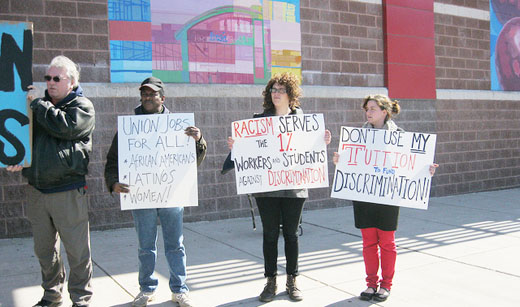
The U.S. Supreme Court has agreed to hear a case that could mean the death knell for racial and ethnic diversity on college campuses. It could threaten gender-based affirmative action as well.
But, despite the notion that the High Court is “protected” from public opinion and politics, the American people do have the ability to influence the case’s outcome.
Ever since the modern-day civil rights movement and its victories, the extreme right wing in the United States has been gunning for any and all democratic gains from those struggles. This includes remedies for past and present discrimination, such as affirmative action.
Affirmative action has already been hobbled by the Bakke decision, and state laws driven by Ward Connerly and crew. This is the logical outcome of a campaign to destroy government mediation in cases of past and present discrimination.
Today the Supreme Court is packed with legal representatives of this extreme right-wing worldview.
In 2003, the Supreme Court ruled that universities could take into account racial and ethnic diversity in their admissions process, although they could not use “quotas.” Justice Sandra Day O’Connor was the author of the majority opinion in that 5-4 ruling.
Public universities could use race in their complex admission point system, as they use children of alumni as a factor, because the goal of racially diverse campuses was good for the country, democratic, and constitutional, the court said.
And indeed studies show that while class-based considerations can increase the numbers of black and Latino college students, race-based considerations result in slightly higher percentages, more reflective of the population at large.
In 2004, one study of 146 selective colleges and universities found that Blacks and Latinos would account for 4 percent of the student body without any affirmative action considerations. Affirmative action based on race/ethnicity increased that number to 12 percent, the study found. With socio-economic affirmative action the number of black and Latino students would have been 10 percent. In the U.S. population as a whole, African Americans and Latinos make up 13 and 16 percent, respectively.
O’Connor retired in 2005 and in her stead President George W. Bush appointed Samuel Alito, who vehemently opposes any attempts to remedy racial, gender or other types of discrimination.
The four dissenting justices in 2003 were Anthony Kennedy, Antonin Scalia, Clarence Thomas and William Rehnquist. Chief Justice John Roberts, who has written opinions hostile to remedies for racist discrimination, replaced Rehnquist. In short, the court is even further to the right and hostile to civil rights than it was in 2003.
To make matters worse, on the more liberal side of the court, Justice Elena Kagan is recusing herself from the case. She was the Obama administration’s solicitor general and worked on the case before being appointed to the Supreme Court.
It looks grim indeed. The court will hear arguments this fall on the case, which is based on a white student’s suit against the University of Texas claiming she was denied admission because of her race. It is sure to be an issue in the 2012 elections.
The far right will try to throw sand in the electorate’s eyes with claims of “reverse discrimination,” that men and whites will have rights taken away.
These are divide-and-conquer tactics. Affirmative action is a remedy for past and present discrimination. Equal protection under the Constitution is there exactly for that reason – to remedy the ongoing damage from the racist institution of slavery. Racism and other forms of discrimination still exist. Therefore remedies need to exist. These remedies have benefited all Americans, including women, people with disabilities and others.
That’s where the American people come in. Electing a president and Congress that will stand squarely with civil rights and diversity sends a message to the court, a message they will hear loud and clear. Just think of how much more further right the court could go with a President Rick Santorum, Mitt Romney, Newt Gingrich or Ron Paul.
Defeating the enemies of affirmative action in the elections is not the only way to fight. Students, families, unions, schools – the 99% – have to send other messages through petitions, demonstrations, letters to the editor, online campaigns, that racial diversity and affirmative action are valued and necessary for a 21st century democratic America.
Photo: PW/Ben Sears


 Join Now
Join Now